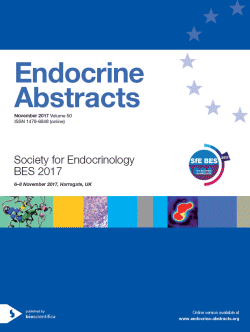
Society for Endocrinology BES 2017
Harrogate,
UK
06 Nov 2017 - 08 Nov 2017

ePoster Presentations
Neuroendocrinology and Pituitary
ea0050ep065 | Neuroendocrinology and Pituitary | SFEBES2017
A rare case of primary suprasellar meningeal melanocytoma associated with nonfunctional pituitary adenoma
Paveluc Oana Stefania , Dobrescu Ruxandra , Stancu Cristina , Dumitrascu Anda , Pop Doina , Badiu Corin
ea0050ep066 | Neuroendocrinology and Pituitary | SFEBES2017
Case report: Indolent IgG4 hypophysitis with partial anterior pituitary failure
Cheah Seong Keat , Krishnan Singhan , Mathews Anitha , Seshadri Shyam
ea0050ep067 | Neuroendocrinology and Pituitary | SFEBES2017
A case of plurihormonal TSHoma presenting as meningitis
Khan Shoaib , Grossman Ashley , Cudlip Simon , Mohammadi Bahram Jaffar , Ansorge Olaf , Pal Aparna
ea0050ep069 | Neuroendocrinology and Pituitary | SFEBES2017
A mysterious pituitary adenoma
Annapurni Anupriya , Rathi Manjusha
ea0050ep070 | Neuroendocrinology and Pituitary | SFEBES2017
Tolosa hunt syndrome: a rare cause of hypopituitarism
Jones Alistair , O'Kane Emma , Keifer Nikki , Bremner Emma , Bhake Ragini , Levy Miles , Reddy Narendra
ea0050ep071 | Neuroendocrinology and Pituitary | SFEBES2017
Cushing’s disease caused by pituitary macroadenoma exhibiting Crooke’s hyaline changes and immunoreactivity for adrenocorticotrophic hormone and growth hormone
Novodvorsky Peter , Ince Paul G , Sinha Saurabh , Debono Miguel
ea0050ep072 | Neuroendocrinology and Pituitary | SFEBES2017
Multi-drug resistant hyperprolactinaemia – a rarity or a rising entity?
Sharma Aditi , Avari Parizad , Wijetilleka Sajini , Qureshi Asjid
ea0050ep073 | Neuroendocrinology and Pituitary | SFEBES2017
Distracting spontaneous refractory hypoglycaemia
Cheah Seong Keat , Rajan Roby , Mathews Abraham , Grant John , Krishnan Singhan , Mathews Anitha , Seshadri Shyam
ea0050ep074 | Neuroendocrinology and Pituitary | SFEBES2017
Recurrent lymphocytic hypophysitis during two pregnancies: a very rare case
Chandan Joht Singh , Gittoes Neil , Toogood Andrew , Karavitaki Niki
ea0050ep075 | Neuroendocrinology and Pituitary | SFEBES2017
A rare case of SDHB mutation in a male individual with pituitary adenoma, and paraganglioma/phaeochromocytoma syndrome
Kounnis Valentinos , ElMuhtadi Saeed ElMuhtadi , Pal Aparna , Tadman Mike , Jafar-Mohammadi Bahram
ea0050ep076 | Neuroendocrinology and Pituitary | SFEBES2017
Secretory Head and Neck Paraganglioma – A rare entity
Saeed Tamar , Tadman Michael , Pal Aparna , McKeith Samuel , Jafar-Mohammadi Bahram
ea0050ep077 | Neuroendocrinology and Pituitary | SFEBES2017
AIP mutation causing familial pituitary tumours
Cordiner Ruth , McManus Frances , Hughes Kate , Panarelli Maurizio , Boyle James , Drummond Russell , Carty David
ea0050ep078 | Neuroendocrinology and Pituitary | SFEBES2017
A partial hypopituitarism case that resolved following bariatric surgery
Mitan Alan , Irshad Fahd , Bukhari Syed , Nyunt Aye
ea0050ep079 | Neuroendocrinology and Pituitary | SFEBES2017
Siadh associated with neuromyelitis optica involving hypothalamus
Papamargaritis Dimitris , Levy Miles J , Reddy Narendra L , Bhake Ragini C
ea0050ep080 | Neuroendocrinology and Pituitary | SFEBES2017
Paraneoplastic Cushing's syndrome associated with neuroendocrine tumour of the pancreas: A case report and review of literature
Alkrekshi Akram , Patel Aarti , Garg Anakul
ea0050ep081 | Neuroendocrinology and Pituitary | SFEBES2017
A rare case of a functioning retroperitoneal paraganglioma in a patient with recurrent Phaeochromocytoma/Paraganglioma (PPGL)
ea0050ep082 | Neuroendocrinology and Pituitary | SFEBES2017
Ipilimumab induced hypophsitis. A new cause for a rare disease
Shagali Hind , Chinnusamy Ravikumar
ea0050ep083 | Neuroendocrinology and Pituitary | SFEBES2017
Secondary adrenocortical insufficiency and renal impairment in a patient presenting with Hyperprolactinaemia
Aslam Muhammad Waseem , Rippin Jonathan
ea0050ep084 | Neuroendocrinology and Pituitary | SFEBES2017
Aggresive Ectopic ACTH production causing Cushing's
Kasouridis Ioannis , Kurera Isuri , Tringham Jennifer
ea0050ep085 | Neuroendocrinology and Pituitary | SFEBES2017
Severe hypoglycaemia in a woman with secondary hypoadrenalism and an abnormal pituitary stalk, complicating metastatic breast carcinoma
Kamath Chandan , Premawardhana Lakdasa , Adlan Mohammed
ea0050ep086 | Neuroendocrinology and Pituitary | SFEBES2017
Cushing's disease - Case report
ea0050ep087 | Neuroendocrinology and Pituitary | SFEBES2017
A 32 Year old Nigeria Male with Azoospermia Who Presented with Bilateral Gynecomastia at The State Specialist Hospital Akure – A Case Report and Review of Literature
Enikuomehin Adenike , Muhammad Fakhraddeen , Adebayo Joseph , Soyoye David , Ikem Rosemary , Kolawole Babatope
ea0050ep088 | Neuroendocrinology and Pituitary | SFEBES2017
Was it Growth hormone deficiency?
Zaidi Muhammad Shoaib , Alrubeaan Khalid , Alfarsi Yousuf



